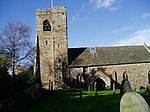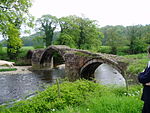Great Mitton

Great Mitton is a village and a civil parish in the Ribble Valley, Lancashire, England. It is separated from the civil parish of Little Mitton by the River Ribble, both lie about three miles from the town of Clitheroe. The combined population of both civil parishes at the 2011 census was 266. In total, Great and Little Mitton cover less than 2000 acres of the Forest of Bowland, making it the smallest township in the Forest. Historically, the village is part of the West Riding of Yorkshire, but was transferred to Lancashire for administrative purposes on 1 April 1974, under the provisions of the Local Government Act 1972. Great Mitton has an ancient church, All Hallows, an ancient manor house and a pub, The Three Fishes, where in former times manorial courts were held. A second pub, The Aspinall Arms, sits across the Ribble in Little Mitton. The ancient parish of Mitton took its name from the Old English, being a settlement at the mythe, the confluence of the Hodder and Ribble Rivers.
Excerpt from the Wikipedia article Great Mitton (License: CC BY-SA 3.0, Authors, Images).Great Mitton
Mitton Road, Ribble Valley
Geographical coordinates (GPS) Address Nearby Places Show on map
Geographical coordinates (GPS)
| Latitude | Longitude |
|---|---|
| N 53.846 ° | E -2.435 ° |
Address
Mitton Road
Mitton Road
BB7 9PL Ribble Valley
England, United Kingdom
Open on Google Maps










